How a Dictation Journal Improves Speaking, Reading, and Writing (VIDEO)
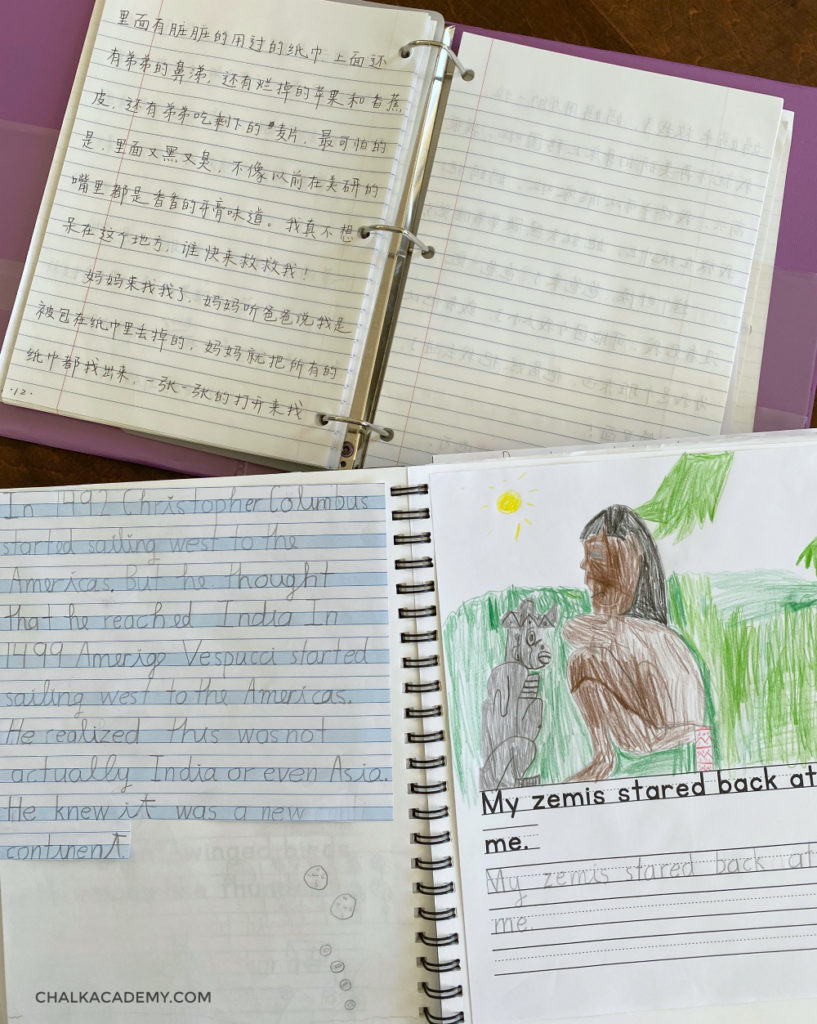
My first grade daughter has been through various stages of writing with English, Chinese, and Korean since she was a toddler. Her weekly dictation journal has been one of the best resources.
Recently, my toddler son started his dictation journal, and I’ll show you how a collaborative journal strategy helps various stages of learning.
Writing takes significant time to master and requires coordination of complex cognitive and physical skills.
Before a child can write independently, ideas must be organized, and fine motor skills must be coordinated.

Chalk Academy is reader-supported. Some of the links are affiliate links. When you buy something through an affiliate link, we may earn a very small commission at no cost to you. Details here.
With alphabet-based languages like English and Korean, a child needs to know phonics and spelling. On the other hand, learners must remember Chinese stroke order and Chinese characters.
Dictation – the act of writing what someone else has said – can bridge the gap between speaking and writing.
In this post, I will explain:
- Benefits of a dictation journal
- When to consider dictation
- Examples dictation strategies for all ages
- “Sharing the pen” and transition to independent writing
- Copywork and dictation
- Digital alternatives to handwriting
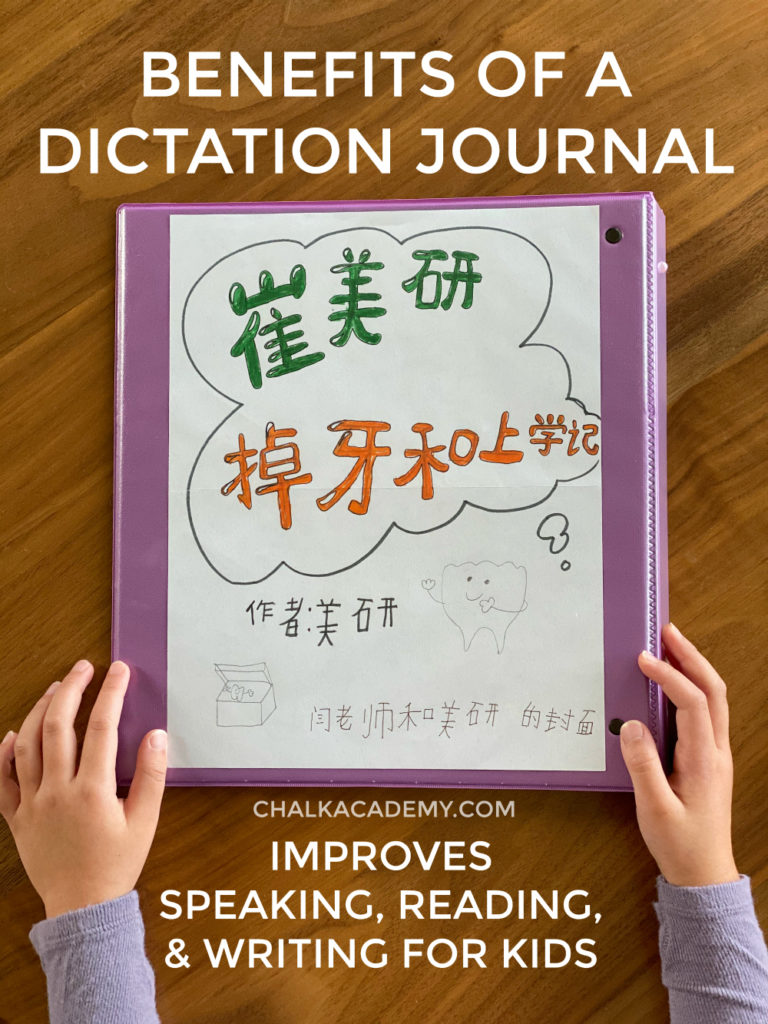
1. How a dictation journal improves speaking, reading, and writing
By removing the physical task and concentrating on self-expression, my 6-year-old daughter’s speaking, reading and writing skills have all improved with her dictation journal.
My 3-year-old son is also learning to express himself; he’s motivated to read I write, because they are his ideas.
If your child has a private language teacher or if you’re helping your child acquire language skills, a dictation journal is worth adding to the routine.
Through a dictation journal, a teacher can demonstrate:
- That writing is meaningful and important
- How to form alphabet letters into words or Chinese strokes into characters
- Correct use of punctuation and spacing
- Patience with listening to speech and writing associated words
More teaching tips for multilingual kids
- How to encourage and maximize the minority language
- Ways to improve listening and speaking
- Creating a prepared environment for reading
- Writing ideas and worksheets

2. When to start implementing a dictation journal
Different ages
For toddlers, dictation can begin by labeling with a word or phrase.
In the early elementary years, a teacher or parent can help with dictating sentences or even regular journal entries.
As a child matures, she takes on the role of careful listening and note-taking during class.
Different languages
For multilingual children, language skills can be quite variable depending on exposure and opportunity for fluency.
Therefore, a child may be ready for dictation in one language but not the other.
Alternatively, a child may be ready to journal independently in one language but benefit from prolonged dictation in the other.

3. Examples of dictation strategies

(1) Toddlers and preschoolers
Sketch book dictation journal
Currently, my 3-year-old son is using a sketch pad to keep track of his daily doodles. After he draws a picture, I praise his efforts and ask them to describe the art.
Since Mandarin is one of our family’s minority languages, I focus on encouraging Chinese dialogue.
If he gives permission, I label the picture with his description.
When my children were just beginning to speak, this could be one word, such as “花 (huā / flower). Eventually, this would progress full sentence “三朵花在草地上 (Sān duǒ huā zài cǎodì shàng / 3 flowers are on the ground).”
Blank spaces can be filled to create a print-rich environment – but only with the child’s consent!

Easel dictation
Both of my children love drawing on our easel! When my daughter was younger, she would doodle, and I’d ask her what she’d like me to write.
Now my son loves to doodle, and sister will ask to write something for him. In the above photo, my son drew a swan, and sister wrote the corresponding 咏鹅 Tang poem.
As she’s still learning to write, she has a couple of errors:
- The strokes at the top of 白 (bái / white) and 向 (xiàng / towards) are in written in reverse
- 波 (bō / wave) is missing the 钩 / 鉤 (gōu / hook)
But we’re all modeling learning from each other!
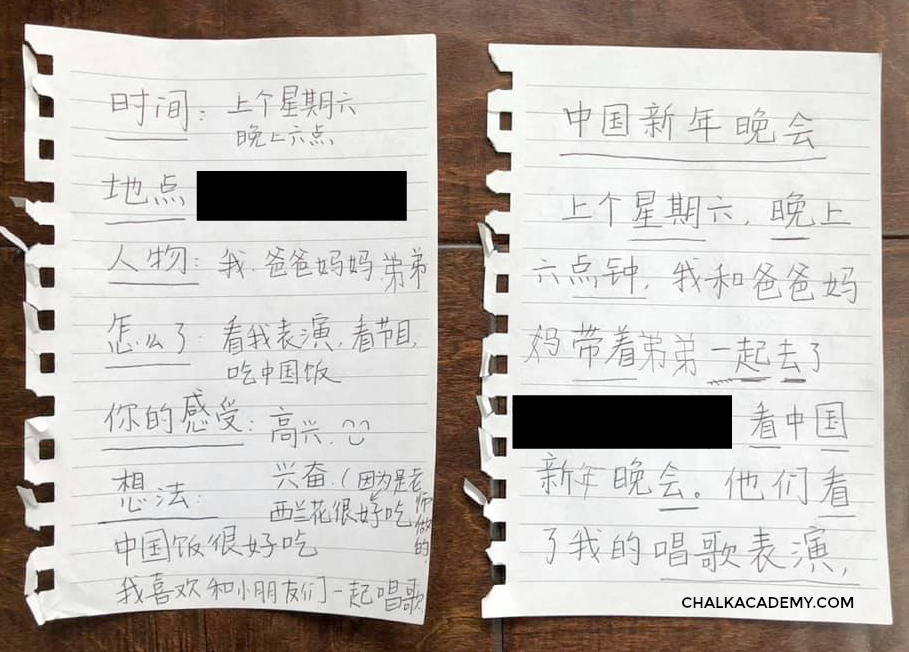
(2) Ways to use a dictation journal with elementary school students
a) Dictation of personal experiences
When my daughter was 5, her Chinese teacher tried to introduce journaling, but my daughter had no interest for a few months.
This was surprising to me as she had been motivated to do copywork and writing greeting cards in Chinese.
However, after my daughter read 米小圈上学记 series last summer and seeing her teacher’s childhood diary, she was inspired to start her own journal.
Over the past half year, this dictation journal has been a very fun part of my daughter’s Chinese tutoring sessions.

Speaking in only Chinese, teacher would ask my daughter to describe herself, her brother, and other important life experiences.
While verbally repeating back what my daughter said, she would take notes in the journal and point out new Chinese characters.
After class, my daughter has enjoyed re-reading the diary entries to herself or out loud to me!
Here’s a video of my daughter reading an entry about her friend.
b) Dictation of creative, fictional content
For fun, my daughter has tried dictating a few creative pieces inspired by adventures from losing her first few baby teeth.
These exercises stretch her imagination and give her a chance to explore storytelling!
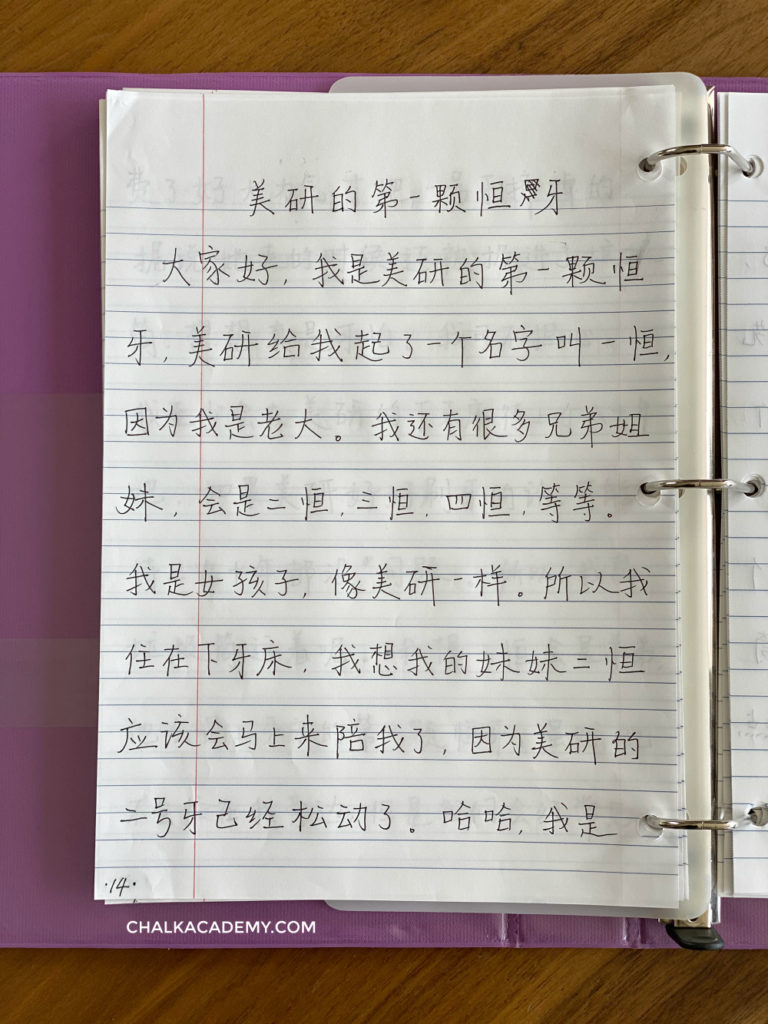
c) Dictation of literature and history analysis
At the start of first grade (classical conversations school), my daughter’s homework was to dictate 1-2 sentence reflections of history and English literature books.
In school, they call this a “narration journal.”

After reading a chapter of Story of the World for example, I would ask her what was most memorable and then write down what she said.
However, since my daughter has been writing English letters for a few years, she felt comfortable with writing in her journal.
So after we read a book:
- She tells me what she thinks
- I write it down on scrap paper
- She copies each sentence into her journal
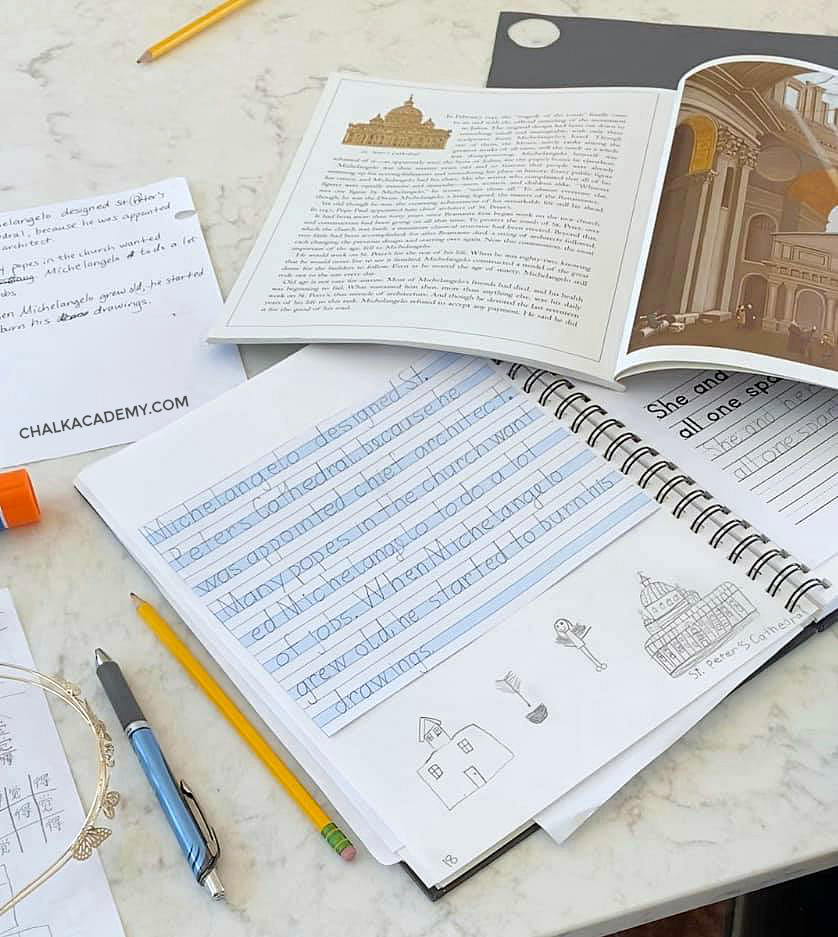
combination of dictation and copywork
4. Copywork with dictation journal
As mentioned in the above example, dictation can be used in combination with copywork or separately.
While a child is learning to express themselves verbally, they can work on building confidence through tracing worksheets or copying something of interest.
I’ve shared before how my daughter chooses favorite Chinese songs and English bible verses for self-motivated copywork which you can learn more about in this article.
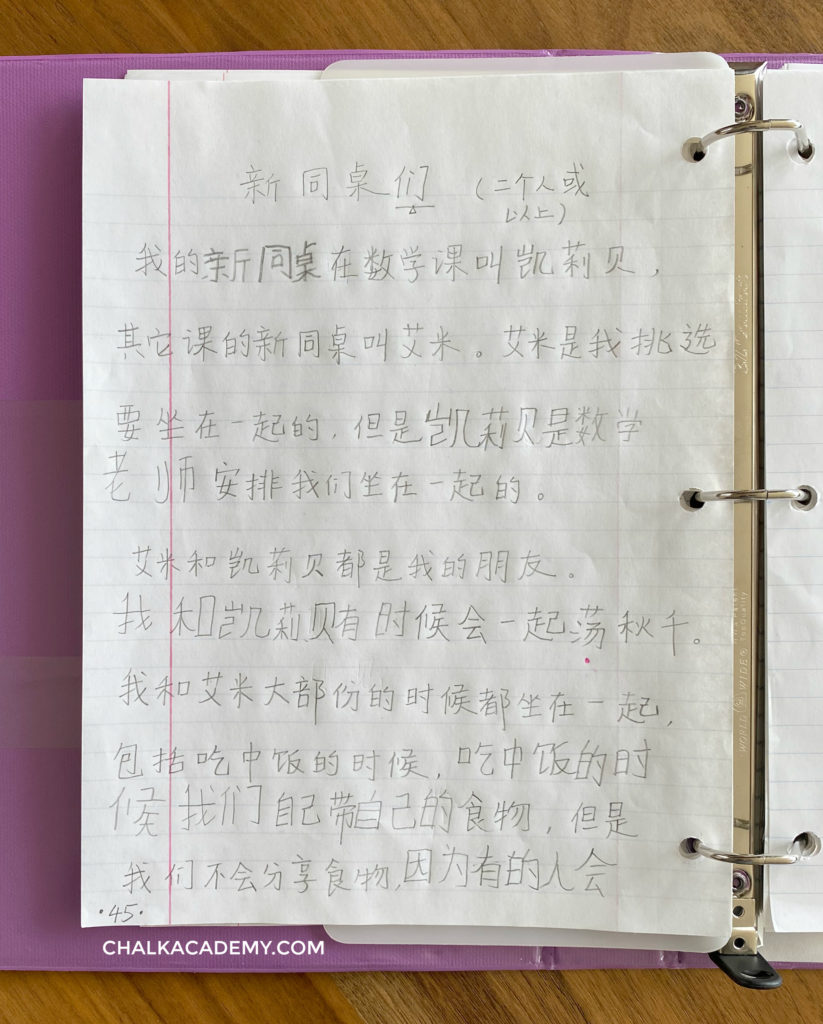
5. “Sharing the pen” and transitioning to independent journaling
The page number “45” in the above image reveals that learning to journal has been a very gradual process.
Since my daughter is gradually better at memorizing Chinese characters, she and her teacher take turns writing in her journal.
Over 40 pages were written by the teacher before my daughter felt ready to write in her journal!
Currently, they are still “sharing the pen”: she writes the Chinese characters that she knows, while her teacher fills in the rest.
In multilingual children, skills can vary with each language component. Despite my daughter’s Chinese reading level being far more advanced than English, the writing levels are reversed.
In any case, following the child’s pace remains important for building confidence and self-motivation to learn.
Try this: 有道 Youdao Chinese Dictionary Pen
6. Digital alternatives to a dictation journal
For those who find handwriting too cumbersome, or for children working with online tutors, typing is a great alternative. Currently, my daughter is dictating journal entries with her new Chinese tutor during video lessons.
In addition, programs like the Book Creator app can be very encouraging for students to dictate their ideas and publish an e-book!
Have you tried dictation strategies with your child or student?
Please share your experience in the comments below!
We’d love to hear what has or hasn’t worked for your family.
If this concept is new to you, feel free to forward this article to your teacher or school!
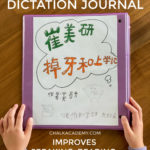
What an extraordinarily helpful post, Betty! Thank you so much for sharing this technique and details about how to implement it!
I know you have written about greeting card making before, but, my 5yo son has not been too interested in that yet, so, getting him to practice writing has been a struggle. He LOVES drawing pictures and telling stories though, so, I think this may be our solution! Thanks again!!!
Thank you for taking the time to read the post! Drawing pictures and telling stories are wonderful skills that you can build from! I hope the dictation idea can be helpful for your son! 🙂